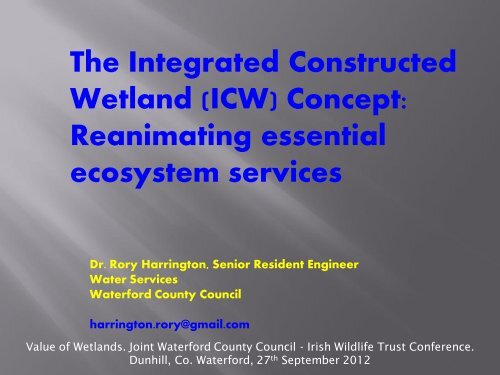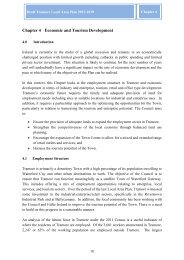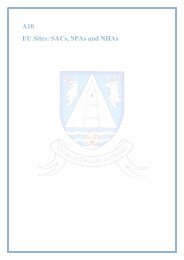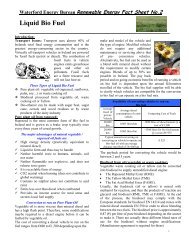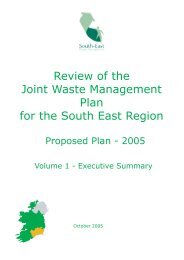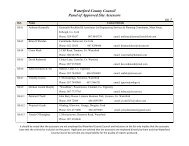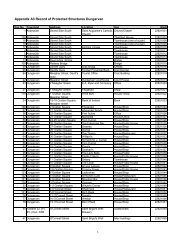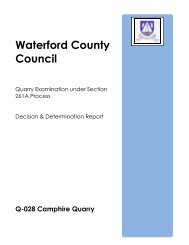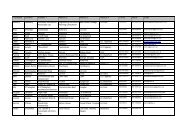The ICW Concept by Dr. Rory Harrington - Waterford County Council
The ICW Concept by Dr. Rory Harrington - Waterford County Council
The ICW Concept by Dr. Rory Harrington - Waterford County Council
Create successful ePaper yourself
Turn your PDF publications into a flip-book with our unique Google optimized e-Paper software.
<strong>The</strong> Integrated Constructed<br />
Wetland (<strong>ICW</strong>) <strong>Concept</strong>:<br />
Reanimating essential<br />
ecosystem services<br />
<strong>Dr</strong>. <strong>Rory</strong> <strong>Harrington</strong>, Senior Resident Engineer<br />
Water Services<br />
<strong>Waterford</strong> <strong>County</strong> <strong>Council</strong><br />
harrington.rory@gmail.com<br />
Value of Wetlands. Joint <strong>Waterford</strong> <strong>County</strong> <strong>Council</strong> - Irish Wildlife Trust Conference.<br />
Dunhill, Co. <strong>Waterford</strong>, 27 th September 2012
Deforestation and Grazing<br />
REFERENCE<br />
D<br />
r<br />
a<br />
i<br />
n<br />
a<br />
g<br />
e<br />
Ireland’s ecology is a<br />
fundamentally altered one
State Arterial <strong>Dr</strong>ainage in Ireland and loss of<br />
wetland ecosystem services<br />
Blue – pre 1945<br />
Red – post 1945
<strong>The</strong> increased need for food
Ireland’s grass-cattlebased<br />
food economy<br />
…half an hour later
Animal slurry, waste and<br />
polluted water is both a<br />
danger and opportunity!<br />
Water and its constituents<br />
can be recycled<br />
<strong>ICW</strong> systems<br />
produce clean<br />
water and<br />
provide many<br />
additional<br />
residual-values +<br />
benefits
Published<br />
December 2010<br />
with<br />
contributions<br />
from:<br />
Department of<br />
Agriculture, Fisheries &<br />
Food<br />
Forest Service<br />
Environmental Protection<br />
Agency<br />
Central Fisheries Board<br />
Eastern Regional<br />
Fisheries Board<br />
Office of Public Works<br />
<strong>County</strong> and City<br />
Managers’ Association<br />
Department of<br />
Environment, Heritage &<br />
Local Government<br />
National Parks & Wildlife<br />
Service<br />
Éamon de Buitléar
Shallow water depth and<br />
emergent vegetation providing:<br />
• High hydraulic<br />
impedance<br />
• Stable anaerobic + O 2<br />
zones<br />
• High primary<br />
productivity<br />
Dissolved O 2 isotherms / water depth
Facilitating the biofilms active on all<br />
supporting strata<br />
On: Solid substrates (rock, soils, plants<br />
and detritus)<br />
Liquid – air (gaseous) interfaces<br />
Soft tissue of living organisms<br />
It’s<br />
A 3.8 billion year long delopment<br />
In and on vegetation, detritus<br />
and soils<br />
Complex microbial<br />
relationships: commensal,<br />
symbiotic and parasitic
Using local or in-situ soils
Biofilms and hydrogels
UNIVERSAL DESIGN MODEL<br />
•Sustainable<br />
•Robust<br />
•Effective<br />
•Fit for purpose<br />
AESTHETIC<br />
•Beautiful<br />
•‘In context’
Explicit integration provides:<br />
synergies, robustness and acceptability
Interdisciplinary<br />
Interdisciplinary<br />
Science is a complex business, as this map of journal cross-citations shows. Each node represents a<br />
subdiscipline and the lines represent the strength of similarity between the nodes.<br />
Image: Rafols, I et al., Science overlay maps
Basic <strong>ICW</strong> hydraulic model<br />
Wetland emergent vegetation<br />
intercepting precipitation<br />
Wind speed, light & temperature<br />
influencing evapo-tanspiration<br />
(Typically 20-40%)<br />
Precipitation<br />
(Typically 120-200% of open pan<br />
transpiration)<br />
Influent<br />
Cell 1.<br />
C.1x10 -10 m/s<br />
Freeboard at<br />
each cell<br />
delays<br />
through-flow<br />
Decreasing through-flow with increasing area<br />
Cell 2.<br />
C.1x10 -9 m/s<br />
Cell 3<br />
C.1 x10 -8 m/s<br />
Impeded seepage/exfiltration (Typical for<br />
landfills >1x10 -9 m/s)<br />
No or occasional<br />
surface discharge
Water management:<br />
‣Source/s identified<br />
‣Point or diffuse<br />
‣Toxicity threshold (ammonium N Conc.
Landscape-fit:<br />
‣Locality/location<br />
‣Adjacent land use<br />
‣Topography<br />
‣Adjacent water related features – water courses etc.<br />
‣Curvilinear or geometric<br />
‣Access<br />
‣Maintenance
Biodiversity:<br />
‣Appropriate local species - source/s identified<br />
‣Species appropriate to each cell<br />
‣Configuration details – embankments and pools<br />
‣Multi-cellular, ideally 4 cells, extra cells for pools or<br />
seasonality<br />
‣Adjacent topography and vegetation
Delivering additional benefits; e.g.<br />
amenity and biodiversity - <strong>ICW</strong> systems<br />
have good public acceptability
Anne Valley<br />
catchment area<br />
= 2,500ha; with<br />
16 large (>1ha)<br />
<strong>ICW</strong>systems
Anne Valley catchment’s <strong>ICW</strong> systems<br />
intercepting point and diffuse polluted<br />
water<br />
80% Village conurbation<br />
40%<br />
80%<br />
Overland flow<br />
Farmyard<br />
wastewater
Typical farm <strong>ICW</strong>
Aerial views of the Anne Valley showing Dunhill Village<br />
<strong>ICW</strong> under construction, right
Recently enlarged<br />
Dunhill village <strong>ICW</strong><br />
(operational on 12 July<br />
2012)<br />
Old (1999) <strong>ICW</strong><br />
Functional treatment area =<br />
2670m 2<br />
Newly extended (July 2012) <strong>ICW</strong><br />
Functional treatment area =<br />
9678m 2<br />
Total functional treatment<br />
area = 12348m 2 (a combined<br />
flow PE capacity = c.400)
Starting construction on enlarged Dunhill village <strong>ICW</strong> : November 2011
March 2012
March 2012
August 2012
Molybdate Reactive Phosphorous (mg/l P)<br />
12 farmyard <strong>ICW</strong> systems in the Anne Valley Catchment, Co.<br />
<strong>Waterford</strong>, showing increasing performance with increasing area<br />
350<br />
300<br />
250<br />
n = 2955<br />
Period covered 2001 - Mar 2009<br />
Samples from 12 Farm wetlands<br />
200<br />
150<br />
100<br />
50<br />
0<br />
0 5000 10000 15000 20000 25000<br />
Cumulative treatment area (m 2 )
Phosphorus (mg/L)<br />
Standard Deviation<br />
14<br />
12<br />
Molybdate Reactive Phosphorus<br />
10<br />
Total Phosphorus<br />
8<br />
6<br />
4<br />
Sustainable and consistent<br />
removal of phosphorus<br />
2<br />
0<br />
0 10 20 30 40 50 60 70 80 90 100<br />
% Total Treatment Area<br />
3.5<br />
3.0<br />
2.5<br />
2.0<br />
Molybdate Reactive Phosphorus<br />
Total Phosphorus<br />
1.5<br />
1.0<br />
0.5<br />
0.0<br />
0 10 20 30 40 50 60 70 80 90 100<br />
% Total Treatment Area
Ammonia-N (mg/l)<br />
140<br />
Ammonia-N attenuation through five intensively<br />
monitored <strong>ICW</strong> in Anne Valley, Co <strong>Waterford</strong><br />
between 2001 and 2006 (mean ± SEM)<br />
120<br />
100<br />
80<br />
60<br />
40<br />
c<br />
Site 3 (n= 33-60)<br />
Site 4 (n = 13 to 69)<br />
Site 9 (n = 26-78)<br />
Site 10 (n = 24-67)<br />
Site 11 (n = 51-109)<br />
20<br />
0<br />
0 2000 4000 6000 8000 10000 12000<br />
Cummulative area (m 2 )
Dunhill <strong>ICW</strong> samples taken 5/9/12<br />
Station ID Lab number Location<br />
E coli per 100<br />
mls<br />
Ammonium<br />
mg/l N<br />
MRP mg/l P<br />
7100 833 Pond 1 inlet 1,200,000 49 5.8<br />
7300 834 pond 2 inlet >1,200,000 33 4.1<br />
7400 835 pond 3 inlet
Amenity use of <strong>ICW</strong> systems
Also: Long-term carbon<br />
sequestration (>13t/ha/yr)<br />
A valuable resource;<br />
Secure retention of phosphorus P<br />
and nitrogen N
Improved biodiversity
<strong>ICW</strong> <strong>Concept</strong> provides a platform for<br />
innovation in natural resource management<br />
Resources:<br />
Biomass<br />
Biochar<br />
Nutrient store<br />
Hydrocarbonreplacement<br />
New food crops<br />
Materials<br />
etc...........<br />
Services:<br />
Water supply<br />
Nutrient capture<br />
Carbon sequestration<br />
Flood attenuation<br />
Recreation and<br />
amenity<br />
Biodiversity
Warning!!<br />
It’s important that the fundamental<br />
requirements of the ‘Ecosystem Approach’<br />
and the objectives to obtain multiple benefits<br />
are not overtaken <strong>by</strong> formulaic engineered<br />
approaches, thus compromising the<br />
philosophy of the <strong>ICW</strong> concept.<br />
(Where formulaic engineered solutions are often the<br />
norm, opportunities to deliver on multiple benefits<br />
are often missed due to a ‘tick-the-box’ approach to<br />
design e.g. ‘Sustainable <strong>Dr</strong>ainage Systems’ (SUDS) .)
Summary<br />
‣Integrated Constructed Wetlands (<strong>ICW</strong>) really<br />
work<br />
‣<strong>The</strong>y improve our surface-waters and<br />
landscapes<br />
‣Deliver diverse benefits to many people in an<br />
inherently sustainable, consistent and low<br />
cost/maintenance way.
Dunhill Primary School students


